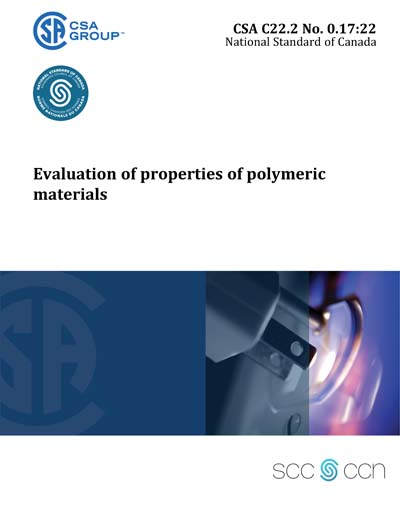Most recent
CSA C22.2 No. 0.17-2022
Evaluation of properties of polymeric materials
Preface This is the third edition of CSA C22.2 No. 0.17, Evaluation of Properties of Polymeric Materials , part of a series of Standards issued by CSA International under Part II of the Canadian Electrical Code. It supersedes the previous editions published in 2000 and 1992. In order to progress toward worldwide standards for the evaluation of plastics materials with respect to safety requirements, the requirements in this Standard are based on Standards issued by the American Society for Testing and Materials (ASTM), International Electrotechnical Commission (IEC), and International Organization for Standardization (ISO). The major changes in this edition are as follows: • external standard references have been updated to reflect document numbering changes; and • a new Clause 6.5has been added to address creep. The minor changes in this edition are as follows: • reference publications have been updated to reflect the latest editions; • scoping clarifies the consideration of components made using additive manufacturing (AM) processes; and • a general safety statement has been added to the Scope. This Standard is considered suitable for use for conformity assessment within the stated scope of the Standard. This Standard was prepared by the Technical Subcommittee on Evaluation of Properties of Polymeric Materials, under the jurisdiction of the Technical Committee on General Requirements, CE Code, Part II and the Strategic Steering Committee on Requirements for Electrical Safety, and has been formally approved by the Technical Committee. This Standard has been developed in compliance with Standards Council of Canada requirements for National Standards of Canada. It has been published as a National Standard of Canada by CSA Group. Scope 1.1 This Standard provides procedures for evaluating polymeric materials and parts made from polymeric materials intended for application in electrical equipment covered by the Canadian Electrical Code, Part II (CE Code, Part II), with respect to: a) flammability; b) mechanical properties; c) thermal properties; d) resistance to weathering; and e) electrical properties. 1.2 The test procedures listed in this Standard are provided for reference in the Standards forming Part II of the Canadian Electrical Code. Although the verbal auxiliary "shall" is used to state the requirements of each test procedure given, it is essential to recognize that the procedures are nonmandatory in themselves unless mandated by individual Standards. Note: Many of these procedures are recognized internationally for evaluating polymeric materials and are equally applicable to areas other than electrical. 1.3 This Standard provides procedures for making reproducible observations and serves as an aid in classifying materials according to the criteria set forth in the individual Standards. 1.4 The procedures described in this Standard involve standard-size specimens tested under laboratory conditions and are intended to be used solely to measure and describe the properties of material. They are intended to serve as a preliminary indication of the material’s acceptability for a particular application. The performance level of a material by these methods might vary in the end use application. 1.5 Test procedures for classifying electrical wires and cables are not specified in this Standard. 1.6 The test methods described in this Standard involve procedures to assess material integrity, electrical properties, and reaction to fire. 1.7 The evaluation of component parts for electrical applications that are produced using additive manufacturing (AM) processes are to be evaluated under the appropriate clauses of this Standard where deemed applicable. Notes: 1) This Standard could involve hazardous materials, operations, and equipment. This Standard does not purport to address all of the safety problems associated with its use. It is the responsibility of the user of this Standard to establish appropriate safety and health practices and determine the applicability of regulatory limitations prior to use. 2) This Standard should be used to measure and describe the properties of materials, products, or assemblies in response to heat and flame under controlled laboratory conditions and should not be used to describe or appraise the fire hazard or fire risk of materials, products, or assemblies under actual fire conditions. However, results of each test may be used as an element of a fire risk assessment that takes into account all of the pertinent factors of a particular end use. 3) The test methods described in this Standard are not intended to assess fire hazard. The fire hazard created by materials depends upon the form and end use of the material. Assessment of fire hazard includes, but is not limited to, many factors, such as ease of ignition, burning rate, flame spread, fuel contribution, intensity of burning, and products of combustion. 1.8 In this Standard, "shall" is used to express a requirement, i.e., a provision that the user is obliged to satisfy in order to comply with the Standard; "should" is used to express a recommendation or that which is advised but not required; and "may" is used to express an option or that which is permissible within the limits of the Standard. Notes accompanying clauses do not include requirements or alternative requirements; the purpose of a note accompanying a clause is to separate from the text explanatory or informative material. Notes to tables and figures are considered part of the table or figure and may be written as requirements. Annexes are designated normative (mandatory) or informative (non-mandatory) to define their application.
CSA America, Inc. [csa]

